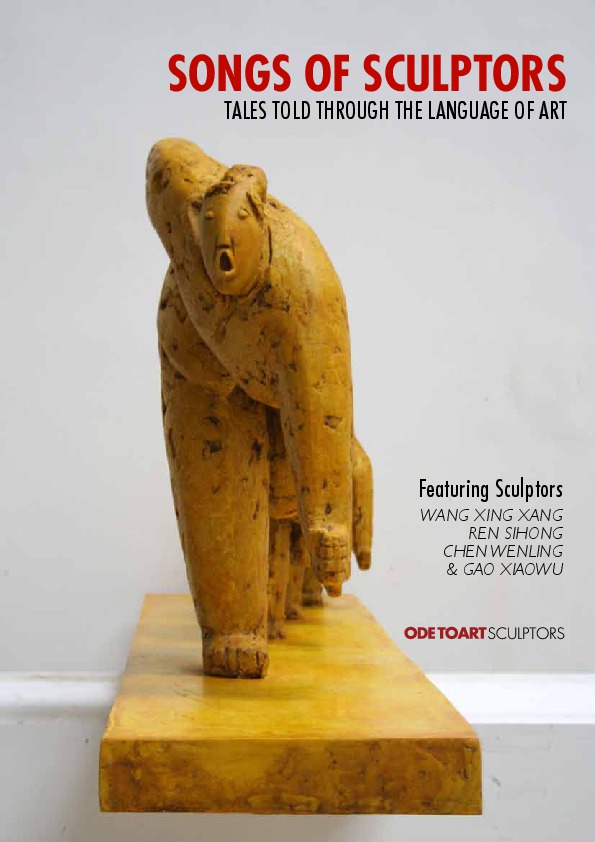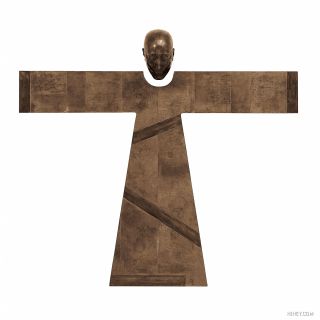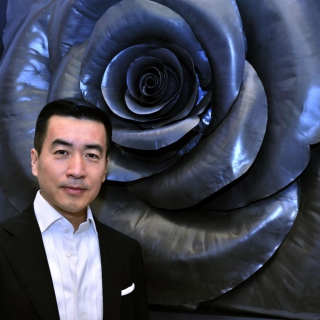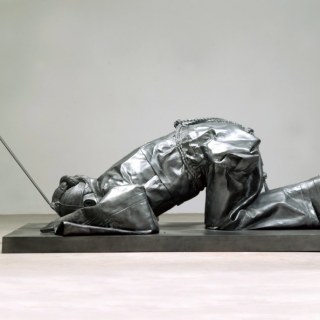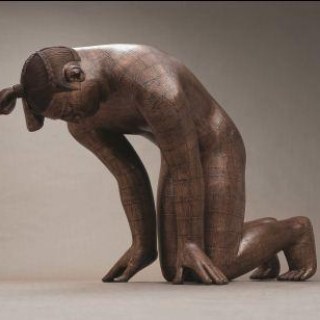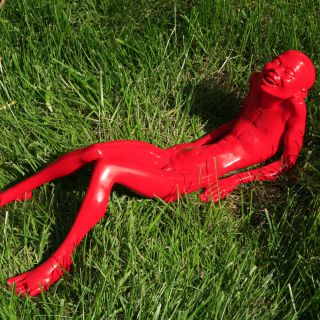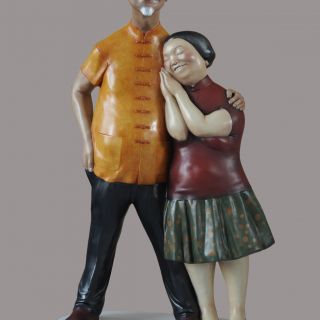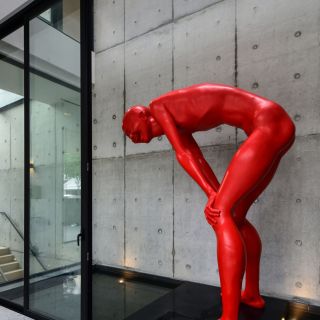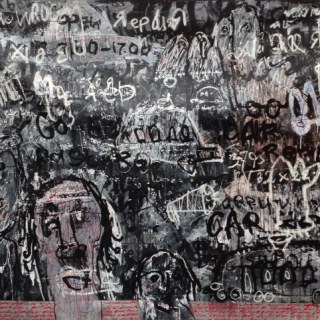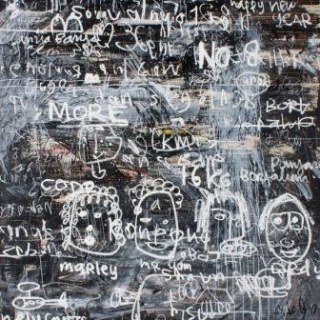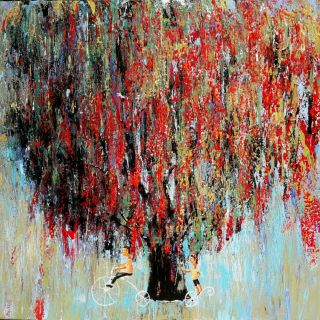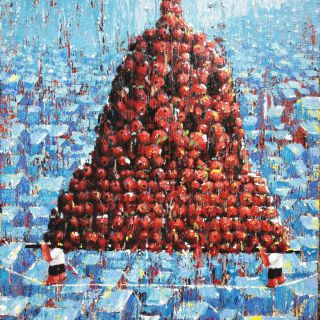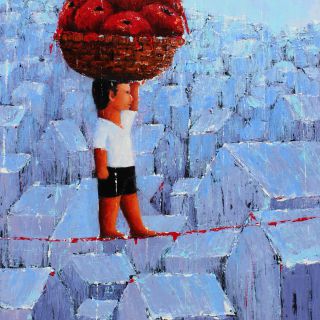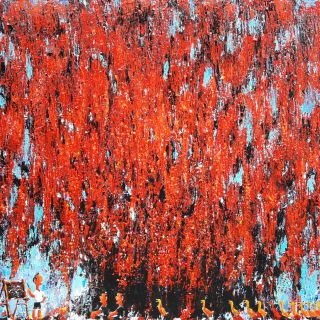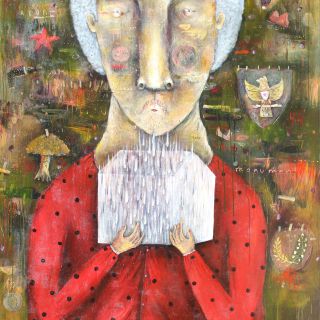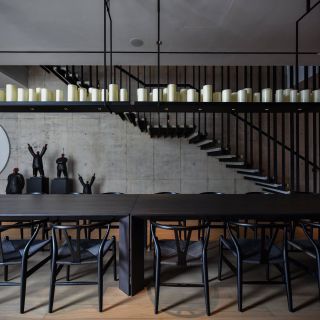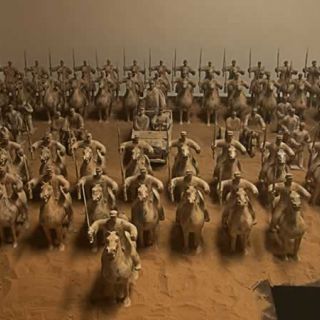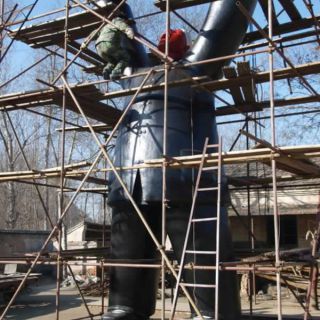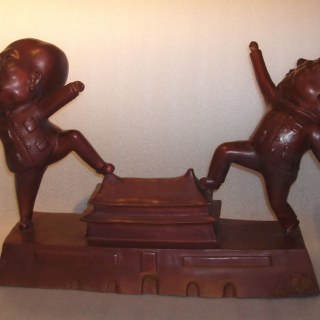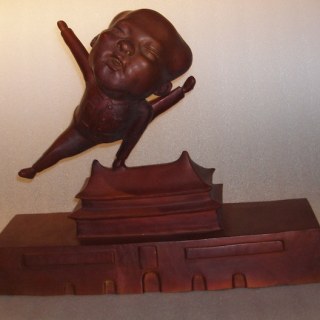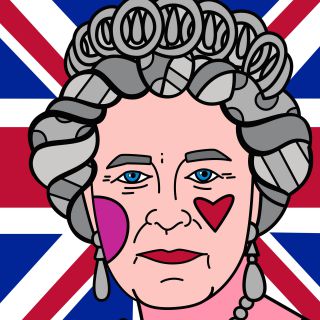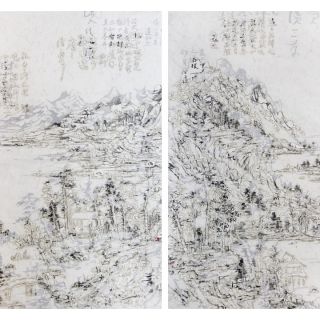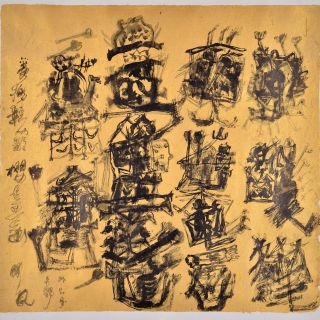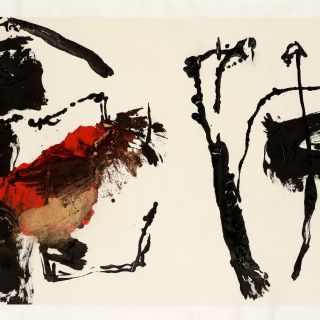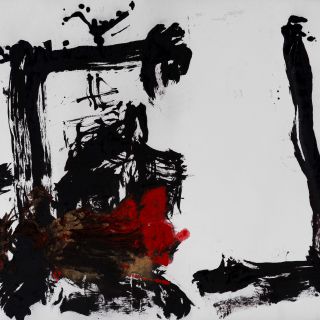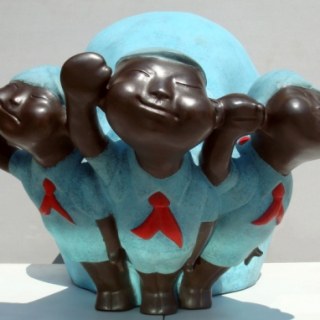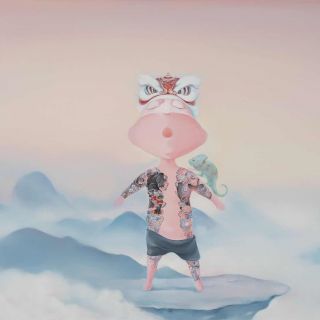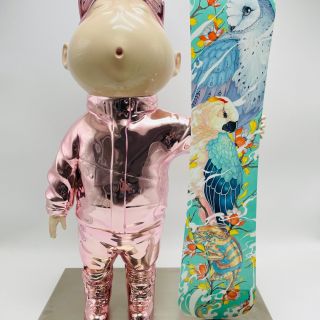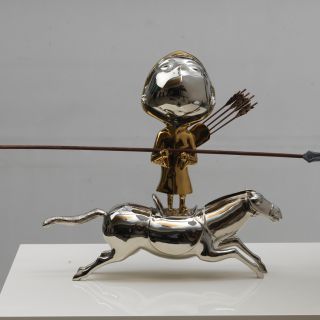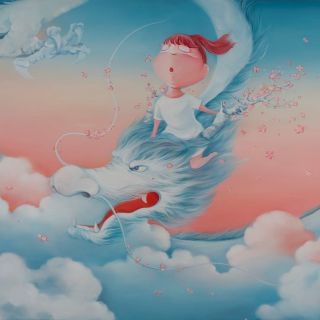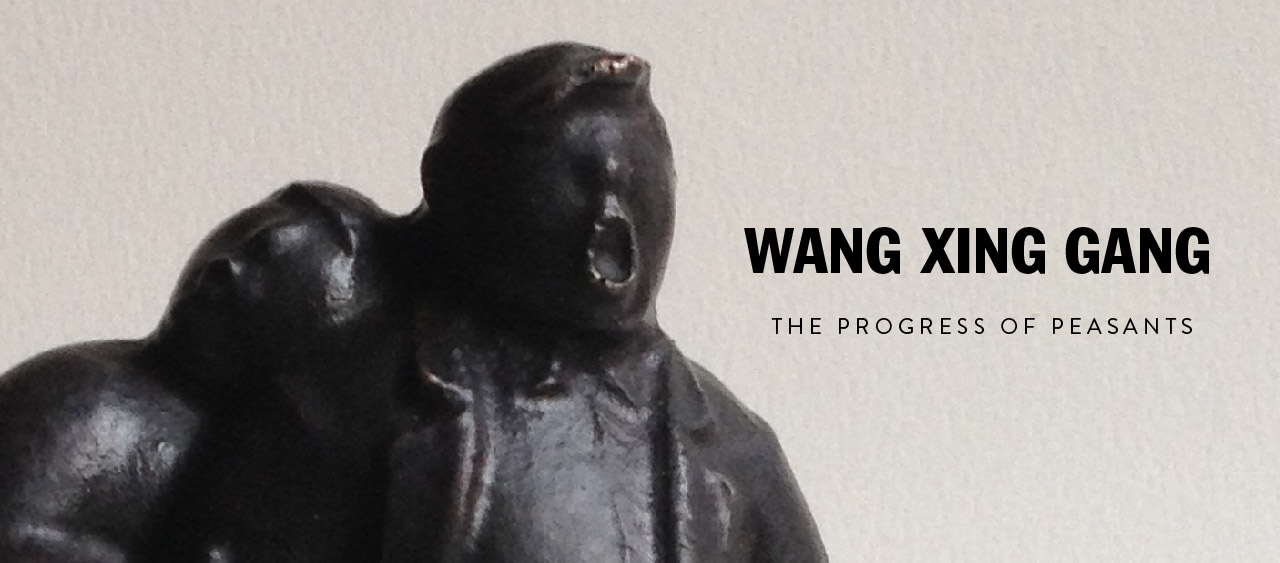
Born in 1971 in Liaoling, northern Provence in China, Wang received a B.S. in sculpture making in Lu Xun Academy of Fine Arts (LXAFA) in 1997. He received a M.A. (Master of Creative Art) in Wollongong University in 2004. His pieces such as "North Wind" have earned him the special prize of the Fourth National Sporting Arts Exhibition and the second prize Liaoning Provincial Art Exhibition. Other winning pieces include "Clearing Up After Drizzle", "Music of Spring" and "Source of Power".
Wang's sculpture is a reflection of the fast-moving circumstances surrounding contemporary society in the People's Republic of China. Wang splits his time between creating sculpture and teaching at Beijing University. His works are a commentary on contemporary Chinese society and the loss of individuality between the demands of work and personal life.
Wang's sculpture is a reflection of the fast-moving circumstances surrounding contemporary society in the People's Republic of China. Wang splits his time between creating sculpture and teaching at Beijing University. His works are a commentary on contemporary Chinese society and the loss of individuality between the demands of work and personal life.
Viewing 5 works by Wang Xing Gang
Sort
Biography 
Biography
Born in 1971 in Liaoling, northern Provence in China, Wang received a B.S. in sculpture making in Lu Xun Academy of Fine Arts (LXAFA) in 1997. He received a M.A. (Master of Creative Art) in Wollongong University in 2004. His pieces such as "North Wind" have earned him the special prize of the Fourth National Sporting Arts Exhibition and the second prize Liaoning Provincial Art Exhibition. Other winning pieces include "Clearing Up After Drizzle", "Music of Spring" and "Source of Power".
Wang's sculpture is a reflection of the fast moving circumstances surrounding contemporary society in the People's Republic of China. Wang splits his time between creating sculpture and teaching at Beijing University. His works are a commentary on contemporary Chinese society and the loss of individuality between the demands of work and personal life.
Wang specializes in sculpting peasants as a reflection of the speedy progress of the Chinese society - forgetting the simple and plain individuals still found in the rural areas of the nation. He emphasizes on the modernization of China, prevalence of contemporary trends and loss of individuality between the demands of work and personal life. Unlike his peers, Wang's focus on rural subjects makes him standout. With his ability to come up with the appropriate blend of both contemporary arts and the topic of countryside in his sculptures, Wang shows his audience his attachment and understanding towards Chinese peasants as well as being able to connect with the modernizing generation. He makes use of his practical experiences and cultural pondering of many years ignite his awareness on the negligence or oversight of those serious problems in the contemporary arts field. In this view, he initiatively chooses and shoulders this cultural responsibility, confines his vision on this field, and focuses on those peasants who are fringed by the urbanization tide.
Selected Exhibitions
2008
The First Annual Moon River Sculpture Festival, The Origin, Beijing, China
Hong Kong International Art Fair, Hong Kong
2007
2nd Art Festival of Song Zhuang, China
France Une International Sculpture Competition, France
2006
Beihang Art Museum
Critique
The Frontage of Conformists - the Concern and Pondering of Wang Xinggang
Du Xiyun
One of the vital transitions of Chinese contemporary fine arts in 1990s is the transfer of visual field---from the perspective of countryside to city, which is more or less related to cultural context transfer. As the drive of willpower of striving for powerful modernization from government as well as from folks, overall developing mode transferred, the focus moved to city, urbanization of countryside, metropolisization of urban city, the booming economy permeated with the ushering of information network and culture globalization. The rapid expansion of urban city and strengthening of citizen society brings out flourish of urban culture, elicits and attracts many unprecedented cultural problems as well. As a result, the city gradually becomes the focus of public attention. The city topics pursued by new generation at the beginning of 90s increasingly become the mainstream of Chinese contemporary arts. Those artists who are being keen on the transition of culture pattern diverted to urbanized creation spontaneously, accordingly, their experiences developed from purely sensitive to abstruse, and increasingly became diversified and microcosmic. Nowadays, the tendency is becoming even more heating.
However, the sculptures of Wang Xinggang always focus on simple and plain peasants, all this appear to be an obvious deviation from the contemporary Chinese arts. Yet being distinct from those artists who take countryside as their topic whereas caring nothing on contemporary arts, Wang Xinggang has always being the central area of contemporary arts, he is not only familiar with the channel of contemporary arts development, but also can actively get involved in it. As for that, his choice is urged by his personal cultural notion, driven by his affection to countryside and peasants.
Superficially, along with the dominant position of urbanization and consuming culture, countryside and peasants has nothing to do with the main field which contemporary arts is concerned with. Accordingly, Wang Xinggang almost falls into isolation. Whereas few contrasts and comparison could make us be aware of the overlapping of agricultural, industrial, post-industrial society under typical social historical background nowadays in China, the enormous economic income gap among different cities, different regions, and different industries, and the gap are being expanded. Due to substantial capital input, policy support, geographical advantage, etc., only a small number of cities developed rapidly, and could be matched with international metropolis. In those developed city, the emergence of pre-consuming society idea, pervasion of consuming culture have become an un-debated fact. Whereas neither this pervasion nor the consuming culture is restricted to the wealthy stratification of those developed cities, the antenna of consuming culture has expanded, permeated to overall regions, including remote and backward places. Therefore, although the countryside in China does not belong to single type of consuming, the consuming culture has long been dominant in this area. Those countryside groups who pursue ideal consuming will highly identify with consuming culture despite of consuming incompetence caused by the economic restriction, meanwhile, they will try to pursue and imitate the practical lifestyle of consuming groups regardless of personal or social economic status, pay the price for the desperate imitation, and even inhibit and sacrifice their basic necessary gratification.
China boasts with large number of peasants, which takes up around three fourth among total population. Needless to mention, they are lying on the lowest stratification of social pyramid, whereas from certain perspective, it is those very lowest groups who function as footstone for various advancements and evolution. However, there is less concern, or we may say in great shortage, on social, cultural contextualized countryside field as well as serious problems emerged from peasant group. The artist, Wang Xinggang, who was born in northeastern China bears sincere affection and certain understanding to Chinese peasants, his practical experiences and cultural pondering of many years ignites his awareness on the negligence or oversight of those serious problems in contemporary arts field. In this view, Wang Xinggang initiatively chooses and shoulders this cultural responsibility, confines his vision on this field, focus on those peasants who are fringed by urbanization tide.
However, the topic of peasants not only takes leading position in the past visual schema but also presents in contemporary visual products, or even being prevalent everywhere. But it has either been garnished in order to meet the demand of urban civilian's sightseeing taste on countryside landscape works or been falsified in the persistent on-the-way thematic culture. Therefore, Wang Xingang's sincere concern and deep presentation must be based on the clear distinction from garnishing and falsifying. Through his works, we may find that he started from the perspective of contemporary arts background, initiated his observation and thinking on the value appealing and mentality of peasants under contemporary cultural context.
As the modernity of spontaneous and voluntary cultural selection, its footstone is individualistic and dominating. But the prevalent footstone in China is conformism-oriented, which is in lack of dominating peculiarity. During the tide of modernization, the description and norm of those dominating culture have always been well set, and the peasants have been chessman who are manipulated and driven by certain authoritative speech. The blind imitation has been the major symptom, and this blind imitation in itself is passive to its end.
After many years, perception and contemplation, Wang Xinggang realizes this major symptom of peasants, which is manifested in his sculpture works. He adopts symbolic language to present those peasants. The waded jacket, cotton trousers remained unchanged hundreds of years, together with liberation shoes produced after the founding of P.R. China, present the life status of peasants who bears strong pre-modernization farming atmosphere, the fallen earth traces of deliberate scratching, piling, together with the Earth Property intensified by the khaki coating, embody their intimate relation with the land or life and death, also reveal the ¡°land¡± complex of the sculptor who is sentimentally attached to the land. He absorbed the sculpt concept of upholding the gist while deleting the minutia, restoring the noble style and being simplistic, emphasizing the momentum, rhyme, and body block so as to give prominence to verve. Accordingly, he adopted the technique of exaggeration, transfiguration, while describing other aspects at only few strokes. By this way, the blind public-oriented mentality driven by dominating consuming culture is standing out. Through his sculpture we may find, those perplexed peasants who are driven by the triggering desire are moving forward in step and following their common lead. Whereas the most surprising point is that even the pacemaker peasant who stands in the foremost frontage is all the same bewildered. Thus when the pacemaker peasant gets stumbled and fallen, all the followers will encounter the same destiny correspondingly.
The works of Wang Xinggang, are actually the symbolic description of the blind behavior leading by conformism consciousness. Under the contemporary cultural context, his works actually gears to the peasants who are surrounded by consuming culture atmosphere. While on the process of deduction and expansion, the consciousness which lacks dominating property is not restricted to consuming culture atmosphere only, but being blind following of every dominating culture. It is not restricted to contemporary peasants, but most probably exists among other groups, including every inspector as well.
Modernity is a kind of plan based on today's imagination to the future, but whether the super plan turns out to be utopia or future reality will depend on the transient on-the-spot action of the participant, depend on the subject. If we say personality determines one's action, action determines one's destiny, then for those blind followers, what the destiny will be?
Wang's sculpture is a reflection of the fast moving circumstances surrounding contemporary society in the People's Republic of China. Wang splits his time between creating sculpture and teaching at Beijing University. His works are a commentary on contemporary Chinese society and the loss of individuality between the demands of work and personal life.
Wang specializes in sculpting peasants as a reflection of the speedy progress of the Chinese society - forgetting the simple and plain individuals still found in the rural areas of the nation. He emphasizes on the modernization of China, prevalence of contemporary trends and loss of individuality between the demands of work and personal life. Unlike his peers, Wang's focus on rural subjects makes him standout. With his ability to come up with the appropriate blend of both contemporary arts and the topic of countryside in his sculptures, Wang shows his audience his attachment and understanding towards Chinese peasants as well as being able to connect with the modernizing generation. He makes use of his practical experiences and cultural pondering of many years ignite his awareness on the negligence or oversight of those serious problems in the contemporary arts field. In this view, he initiatively chooses and shoulders this cultural responsibility, confines his vision on this field, and focuses on those peasants who are fringed by the urbanization tide.
Selected Exhibitions
2008
The First Annual Moon River Sculpture Festival, The Origin, Beijing, China
Hong Kong International Art Fair, Hong Kong
2007
2nd Art Festival of Song Zhuang, China
France Une International Sculpture Competition, France
2006
Beihang Art Museum
Critique
The Frontage of Conformists - the Concern and Pondering of Wang Xinggang
Du Xiyun
One of the vital transitions of Chinese contemporary fine arts in 1990s is the transfer of visual field---from the perspective of countryside to city, which is more or less related to cultural context transfer. As the drive of willpower of striving for powerful modernization from government as well as from folks, overall developing mode transferred, the focus moved to city, urbanization of countryside, metropolisization of urban city, the booming economy permeated with the ushering of information network and culture globalization. The rapid expansion of urban city and strengthening of citizen society brings out flourish of urban culture, elicits and attracts many unprecedented cultural problems as well. As a result, the city gradually becomes the focus of public attention. The city topics pursued by new generation at the beginning of 90s increasingly become the mainstream of Chinese contemporary arts. Those artists who are being keen on the transition of culture pattern diverted to urbanized creation spontaneously, accordingly, their experiences developed from purely sensitive to abstruse, and increasingly became diversified and microcosmic. Nowadays, the tendency is becoming even more heating.
However, the sculptures of Wang Xinggang always focus on simple and plain peasants, all this appear to be an obvious deviation from the contemporary Chinese arts. Yet being distinct from those artists who take countryside as their topic whereas caring nothing on contemporary arts, Wang Xinggang has always being the central area of contemporary arts, he is not only familiar with the channel of contemporary arts development, but also can actively get involved in it. As for that, his choice is urged by his personal cultural notion, driven by his affection to countryside and peasants.
Superficially, along with the dominant position of urbanization and consuming culture, countryside and peasants has nothing to do with the main field which contemporary arts is concerned with. Accordingly, Wang Xinggang almost falls into isolation. Whereas few contrasts and comparison could make us be aware of the overlapping of agricultural, industrial, post-industrial society under typical social historical background nowadays in China, the enormous economic income gap among different cities, different regions, and different industries, and the gap are being expanded. Due to substantial capital input, policy support, geographical advantage, etc., only a small number of cities developed rapidly, and could be matched with international metropolis. In those developed city, the emergence of pre-consuming society idea, pervasion of consuming culture have become an un-debated fact. Whereas neither this pervasion nor the consuming culture is restricted to the wealthy stratification of those developed cities, the antenna of consuming culture has expanded, permeated to overall regions, including remote and backward places. Therefore, although the countryside in China does not belong to single type of consuming, the consuming culture has long been dominant in this area. Those countryside groups who pursue ideal consuming will highly identify with consuming culture despite of consuming incompetence caused by the economic restriction, meanwhile, they will try to pursue and imitate the practical lifestyle of consuming groups regardless of personal or social economic status, pay the price for the desperate imitation, and even inhibit and sacrifice their basic necessary gratification.
China boasts with large number of peasants, which takes up around three fourth among total population. Needless to mention, they are lying on the lowest stratification of social pyramid, whereas from certain perspective, it is those very lowest groups who function as footstone for various advancements and evolution. However, there is less concern, or we may say in great shortage, on social, cultural contextualized countryside field as well as serious problems emerged from peasant group. The artist, Wang Xinggang, who was born in northeastern China bears sincere affection and certain understanding to Chinese peasants, his practical experiences and cultural pondering of many years ignites his awareness on the negligence or oversight of those serious problems in contemporary arts field. In this view, Wang Xinggang initiatively chooses and shoulders this cultural responsibility, confines his vision on this field, focus on those peasants who are fringed by urbanization tide.
However, the topic of peasants not only takes leading position in the past visual schema but also presents in contemporary visual products, or even being prevalent everywhere. But it has either been garnished in order to meet the demand of urban civilian's sightseeing taste on countryside landscape works or been falsified in the persistent on-the-way thematic culture. Therefore, Wang Xingang's sincere concern and deep presentation must be based on the clear distinction from garnishing and falsifying. Through his works, we may find that he started from the perspective of contemporary arts background, initiated his observation and thinking on the value appealing and mentality of peasants under contemporary cultural context.
As the modernity of spontaneous and voluntary cultural selection, its footstone is individualistic and dominating. But the prevalent footstone in China is conformism-oriented, which is in lack of dominating peculiarity. During the tide of modernization, the description and norm of those dominating culture have always been well set, and the peasants have been chessman who are manipulated and driven by certain authoritative speech. The blind imitation has been the major symptom, and this blind imitation in itself is passive to its end.
After many years, perception and contemplation, Wang Xinggang realizes this major symptom of peasants, which is manifested in his sculpture works. He adopts symbolic language to present those peasants. The waded jacket, cotton trousers remained unchanged hundreds of years, together with liberation shoes produced after the founding of P.R. China, present the life status of peasants who bears strong pre-modernization farming atmosphere, the fallen earth traces of deliberate scratching, piling, together with the Earth Property intensified by the khaki coating, embody their intimate relation with the land or life and death, also reveal the ¡°land¡± complex of the sculptor who is sentimentally attached to the land. He absorbed the sculpt concept of upholding the gist while deleting the minutia, restoring the noble style and being simplistic, emphasizing the momentum, rhyme, and body block so as to give prominence to verve. Accordingly, he adopted the technique of exaggeration, transfiguration, while describing other aspects at only few strokes. By this way, the blind public-oriented mentality driven by dominating consuming culture is standing out. Through his sculpture we may find, those perplexed peasants who are driven by the triggering desire are moving forward in step and following their common lead. Whereas the most surprising point is that even the pacemaker peasant who stands in the foremost frontage is all the same bewildered. Thus when the pacemaker peasant gets stumbled and fallen, all the followers will encounter the same destiny correspondingly.
The works of Wang Xinggang, are actually the symbolic description of the blind behavior leading by conformism consciousness. Under the contemporary cultural context, his works actually gears to the peasants who are surrounded by consuming culture atmosphere. While on the process of deduction and expansion, the consciousness which lacks dominating property is not restricted to consuming culture atmosphere only, but being blind following of every dominating culture. It is not restricted to contemporary peasants, but most probably exists among other groups, including every inspector as well.
Modernity is a kind of plan based on today's imagination to the future, but whether the super plan turns out to be utopia or future reality will depend on the transient on-the-spot action of the participant, depend on the subject. If we say personality determines one's action, action determines one's destiny, then for those blind followers, what the destiny will be?
Exhibitions 
Exhibitions
Selected Exhibitions
2016
Wang Xinggang: Prescription for the Soul, Yan Gallery, Hong Kong
2015
Wang Xinggang: Senses of Reality, AP Contemporary, Hong Kong
2014
The Collision and Confluence: Chinese-American Art, Center for Chinese Art at William Paterson University, New York and New Jersey
Garfagnana Innovizione stone carving workshop, Gramolazzo, MUSA ART Museum, Italy
2013
vibrARTion in Four Seasons: Sculptures by Wang Xinggang Four Seasons Hotel, Beijing
9nd Art Festival of Song Zhuang, “Da Xiang You Xing Public Sculptures Exhibition” Song Village, Beijing, China
2012
5th Anniversary Contemporary Sculpture Invitation Bei Jing Finace Street, Beijing, China
"The spirit of the container” Wang Xing Gang and Cai Zhisong sculpture Group Exhibitions Siemens Art Space 798
2011
International Sculpture Exhibition of Datong Biennial Datong He Yang Art Museum
“North Wind”Collected by Institute of Network Coding of The Chinese University of Hong Kong
2008
The First Annual Moon River Sculpture Festival, The Origin, Beijing, China
Hong Kong International Art Fair, Hong Kong
2007
2nd Art Festival of Song Zhuang, China
France Une International Sculpture Competition, France
2006
Beihang Art Museum
2016
Wang Xinggang: Prescription for the Soul, Yan Gallery, Hong Kong
2015
Wang Xinggang: Senses of Reality, AP Contemporary, Hong Kong
2014
The Collision and Confluence: Chinese-American Art, Center for Chinese Art at William Paterson University, New York and New Jersey
Garfagnana Innovizione stone carving workshop, Gramolazzo, MUSA ART Museum, Italy
2013
vibrARTion in Four Seasons: Sculptures by Wang Xinggang Four Seasons Hotel, Beijing
9nd Art Festival of Song Zhuang, “Da Xiang You Xing Public Sculptures Exhibition” Song Village, Beijing, China
2012
5th Anniversary Contemporary Sculpture Invitation Bei Jing Finace Street, Beijing, China
"The spirit of the container” Wang Xing Gang and Cai Zhisong sculpture Group Exhibitions Siemens Art Space 798
2011
International Sculpture Exhibition of Datong Biennial Datong He Yang Art Museum
“North Wind”Collected by Institute of Network Coding of The Chinese University of Hong Kong
2008
The First Annual Moon River Sculpture Festival, The Origin, Beijing, China
Hong Kong International Art Fair, Hong Kong
2007
2nd Art Festival of Song Zhuang, China
France Une International Sculpture Competition, France
2006
Beihang Art Museum
Critique 
Critique
The Frontage of Conformists - the Concern and Pondering of Wang Xing Gang
Du Xiyun
One of the vital transitions of Chinese contemporary fine arts in 1990s is the transfer of the visual field - from the perspective of countryside to city, which is more or less related to a transfer of cultural context. With the drive for powerful modernisation from the government and people, the overall mode of development was transformed greatly. The countryside was urbanised and the urban city became a metropolis, in addition, the booming economy ushered in an information network and a culture of globalisation. The rapid expansion of the city and strengthening of society amongst citizens led to urban culture flourishing, but also attracted many unprecedented cultural problems. Thus, the city gradually became the focus of public attention. City topics pursued by the new generation at the start of the 90's increasingly became mainstream topics addressed in Chinese contemporary art. Artists keen on studying the transition of cultural patterns diverted to spontaneous urbanised creation and, accordingly, their experiences developed from being purely sensitive to abstruse and increasingly became diversified and microcosmic.
As opposed to the aforementioned aspects, the sculptures of Wang Xinggang always focus on simple and plain peasants - an obvious deviation from the contemporary Chinese arts. However, despite being distinct from artists who focus on the countryside as their topic of choice yet choose to ignore contemporary arts, Wang Xinggang has always been a central component of contemporary arts. He is not only familiar with the various channels of contemporary arts development, but is also actively involved in it. His choice is motivated by his personal cultural notion, driven by an affection to the countryside and peasants. Superficially, with the dominant position of urbanization and consuming culture in the main field of contemporary art, the topic of countryside and peasants is far removed and Wang Xinggang almost falls into isolation. Whilst few contrasts and comparisons are available to make one aware of the overlap of agricultural, industrial and post-industrial society under the typical socio-historical background in China, the enormous economic income gap in different cities, regions and industries is constantly increasing. Due to substantial capital input, policy support, geographical advantage, etc., only a small number of cities developed rapidly, and could be matched with the moniker of an ‘international metropolis.’ In those developed cities, the notion of conspicuous consumption has become an indisputable fact. The consumption of culture is not restricted to the wealthy stratification of developed cities alone, rather, it has expanded and permeated various regions, including remote and backward ones. Therefore, although the countryside in China does not match the consumption of a city, the idea of a consuming culture has long been dominant in this area. Countryside groups who engage in consumption can identify greatly with the consuming culture despite economic restrictions and would to pursue and imitate the lifestyle of consuming groups regardless of personal or socio-economic status, paying the price for the desperate imitation, and even inhibiting and sacrificing their basic necessary gratification.
China has a large number of peasants, around three-fourths of their total population. Needless to say, they exist on the lowest stratification of the social pyramid, whereas from certain perspectives, it is these lowest groups who function as foundations for various advancements and evolution. However, there is less concern, or may we say, greater shortage of social and cultural information about the conditions in the countryside as well as serious problems emerging from the peasant group. The artist, Wang Xing Gang, who was born in northeastern China bears sincere affection and certain understanding towards Chinese peasants. His practical experience and cultural considerations over many years have increased his awareness on the negligence or oversight of these serious problems in contemporary arts field. With this view, Wang Xing Gang chooses to shoulder this cultural responsibility and confines his vision to this field in order to focus on peasants who have been overlooked by the tide of urbanization.
The topic of peasants does not only take a leading position in visual schema of the past but is also present in contemporary visual products. However, in these cases, it has either been furnished to meet the demand of an urban civilian's view of how the countryside landscape works or has been falsified to demonstrate thematic culture. Therefore, Wang Xing Gang's sincere concern and deep presentation is distinct from embellishment and falsehood. Through his works, we may find that he addressed the issue from the perspective of a contemporary arts background, initiated his observations and thought based on the value and mentality of peasants in a contemporary cultural context.
The foundation of modernity, with its spontaneous and voluntary cultural selection as topics of choice is individualistic and dominating. However, the prevalent foundation in China is one of conformity. Under tides of modernization, peasants have been manipulated and used like pawns, driven by authoritarians in the more dominant urban cultures. As such, blind imitation is pervasive and passive.
After many years of perception and contemplation, Wang Xing Gang realized that this ‘blind following of dominant trends’ was a major symptom of peasants and this trend manifested in his sculpture works. He has adopted a symbolic language to present peasants - the worn jacket and cotton trousers that have remained unchanged for hundreds of years, together with ‘liberation shoes’ produced after the founding of the People’s Republic of China. As such, the status and lives of peasants are presented. In addition the sculptures are rendered with deliberate scratching, and piling. The property of Earth is revealed in the khaki coating, embodying the peasants’ intimate relationship with the land, life and death and also the ‘land complex’ of the sculptor who bears sentimental attachment to the land. Wang absorbed the sculptural concept of upholding the gist of the sculpture while removing minutiae or detail, thus restoring the nobility of the style and emphasizing simplicity, momentum, rhyme and blocking of the body in order to give prominence to spirit and energy.
Techniques of exaggeration were also adopted to describe other aspects, with the contribution of a few strokes. In this manner, the blind following and conformist mentality that is driven by the dominant culture of consumption stands out. Through his sculpture, we find that perplexed peasants driven by insatiable desire are moving forward in step and following their common lead. Even the lead peasant looks bewildered and what this signifies is that if he commits a misstep, stumbles and falls, all his followers will do so as well.
The works of Wang Xing Gang are symbolic descriptions of blind behavior led by a culture of conformity. In a contemporary cultural context, his works address peasants who are entrenched in an atmosphere of consuming culture. This could be extended to representing a blind following of every culture that seems to be more dominant and is not restricted to contemporary peasants alone, it is a problem that exists among other groups as well.
Modernity is a kind of plan based on today's imagination of the future, but whether the plan turns out to be utopia or future reality is dependent on the actions of participants and subjects. If we say personality determines one's action and action determines one's destiny, then for blind followers, what will their destiny be?
One of the vital transitions of Chinese contemporary fine arts in 1990s is the transfer of the visual field - from the perspective of countryside to city, which is more or less related to a transfer of cultural context. With the drive for powerful modernisation from the government and people, the overall mode of development was transformed greatly. The countryside was urbanised and the urban city became a metropolis, in addition, the booming economy ushered in an information network and a culture of globalisation. The rapid expansion of the city and strengthening of society amongst citizens led to urban culture flourishing, but also attracted many unprecedented cultural problems. Thus, the city gradually became the focus of public attention. City topics pursued by the new generation at the start of the 90's increasingly became mainstream topics addressed in Chinese contemporary art. Artists keen on studying the transition of cultural patterns diverted to spontaneous urbanised creation and, accordingly, their experiences developed from being purely sensitive to abstruse and increasingly became diversified and microcosmic.
As opposed to the aforementioned aspects, the sculptures of Wang Xinggang always focus on simple and plain peasants - an obvious deviation from the contemporary Chinese arts. However, despite being distinct from artists who focus on the countryside as their topic of choice yet choose to ignore contemporary arts, Wang Xinggang has always been a central component of contemporary arts. He is not only familiar with the various channels of contemporary arts development, but is also actively involved in it. His choice is motivated by his personal cultural notion, driven by an affection to the countryside and peasants. Superficially, with the dominant position of urbanization and consuming culture in the main field of contemporary art, the topic of countryside and peasants is far removed and Wang Xinggang almost falls into isolation. Whilst few contrasts and comparisons are available to make one aware of the overlap of agricultural, industrial and post-industrial society under the typical socio-historical background in China, the enormous economic income gap in different cities, regions and industries is constantly increasing. Due to substantial capital input, policy support, geographical advantage, etc., only a small number of cities developed rapidly, and could be matched with the moniker of an ‘international metropolis.’ In those developed cities, the notion of conspicuous consumption has become an indisputable fact. The consumption of culture is not restricted to the wealthy stratification of developed cities alone, rather, it has expanded and permeated various regions, including remote and backward ones. Therefore, although the countryside in China does not match the consumption of a city, the idea of a consuming culture has long been dominant in this area. Countryside groups who engage in consumption can identify greatly with the consuming culture despite economic restrictions and would to pursue and imitate the lifestyle of consuming groups regardless of personal or socio-economic status, paying the price for the desperate imitation, and even inhibiting and sacrificing their basic necessary gratification.
China has a large number of peasants, around three-fourths of their total population. Needless to say, they exist on the lowest stratification of the social pyramid, whereas from certain perspectives, it is these lowest groups who function as foundations for various advancements and evolution. However, there is less concern, or may we say, greater shortage of social and cultural information about the conditions in the countryside as well as serious problems emerging from the peasant group. The artist, Wang Xing Gang, who was born in northeastern China bears sincere affection and certain understanding towards Chinese peasants. His practical experience and cultural considerations over many years have increased his awareness on the negligence or oversight of these serious problems in contemporary arts field. With this view, Wang Xing Gang chooses to shoulder this cultural responsibility and confines his vision to this field in order to focus on peasants who have been overlooked by the tide of urbanization.
The topic of peasants does not only take a leading position in visual schema of the past but is also present in contemporary visual products. However, in these cases, it has either been furnished to meet the demand of an urban civilian's view of how the countryside landscape works or has been falsified to demonstrate thematic culture. Therefore, Wang Xing Gang's sincere concern and deep presentation is distinct from embellishment and falsehood. Through his works, we may find that he addressed the issue from the perspective of a contemporary arts background, initiated his observations and thought based on the value and mentality of peasants in a contemporary cultural context.
The foundation of modernity, with its spontaneous and voluntary cultural selection as topics of choice is individualistic and dominating. However, the prevalent foundation in China is one of conformity. Under tides of modernization, peasants have been manipulated and used like pawns, driven by authoritarians in the more dominant urban cultures. As such, blind imitation is pervasive and passive.
After many years of perception and contemplation, Wang Xing Gang realized that this ‘blind following of dominant trends’ was a major symptom of peasants and this trend manifested in his sculpture works. He has adopted a symbolic language to present peasants - the worn jacket and cotton trousers that have remained unchanged for hundreds of years, together with ‘liberation shoes’ produced after the founding of the People’s Republic of China. As such, the status and lives of peasants are presented. In addition the sculptures are rendered with deliberate scratching, and piling. The property of Earth is revealed in the khaki coating, embodying the peasants’ intimate relationship with the land, life and death and also the ‘land complex’ of the sculptor who bears sentimental attachment to the land. Wang absorbed the sculptural concept of upholding the gist of the sculpture while removing minutiae or detail, thus restoring the nobility of the style and emphasizing simplicity, momentum, rhyme and blocking of the body in order to give prominence to spirit and energy.
Techniques of exaggeration were also adopted to describe other aspects, with the contribution of a few strokes. In this manner, the blind following and conformist mentality that is driven by the dominant culture of consumption stands out. Through his sculpture, we find that perplexed peasants driven by insatiable desire are moving forward in step and following their common lead. Even the lead peasant looks bewildered and what this signifies is that if he commits a misstep, stumbles and falls, all his followers will do so as well.
The works of Wang Xing Gang are symbolic descriptions of blind behavior led by a culture of conformity. In a contemporary cultural context, his works address peasants who are entrenched in an atmosphere of consuming culture. This could be extended to representing a blind following of every culture that seems to be more dominant and is not restricted to contemporary peasants alone, it is a problem that exists among other groups as well.
Modernity is a kind of plan based on today's imagination of the future, but whether the plan turns out to be utopia or future reality is dependent on the actions of participants and subjects. If we say personality determines one's action and action determines one's destiny, then for blind followers, what will their destiny be?

Stay connected.
Sign up to our newsletter for updates on new arrivals and exhibitions


